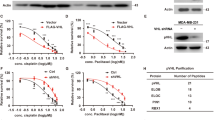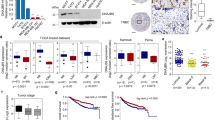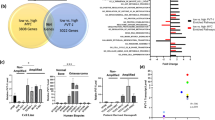Abstract
Elevated levels of the oncoprotein, osteopontin (OPN), are associated with poor outcome of several types of cancers including melanoma. We have previously reported an important involvement of DNAJB6, a member of heat-shock protein 40 (HSP40) family, in negatively impacting tumor growth. The current study was prompted by our observations reported here which revealed a reciprocal relationship between DNAJB6 and OPN in melanoma specimens. The ‘J domain’ is the most conserved domain of HSP40 family of proteins. Hence, we assessed the functional role of the J domain in activities of DNAJB6. We report that the J domain of DNAJB6 is involved in mediating OPN suppression. Deletion of the J domain renders DNAJB6 incapable of impeding malignancy and suppressing OPN. Our mechanistic investigations reveal that DNAJB6 binds HSPA8 (heat-shock cognate protein, HSC70) and causes dephosphorylation of glycogen synthase kinase 3β (GSK3β) at Ser 9 by recruiting protein phosphatase, PP2A. This dephosphorylation activates GSK3β, leading to degradation of β-catenin and subsequent loss of TCF/LEF (T cell factor1/lymphoid enhancer factor1) activity. Deletion of the J domain abrogates assembly of this multiprotein complex and renders GSK3β inactive, thus, stabilizing β-catenin, a transcription co-activator for OPN expression. Our in-vitro and in-vivo functional analyses show that silencing OPN expression in the background of deletion of the J domain renders the resultant tumor cells less malignant despite the presence of stabilized β-catenin. Thus, we have uncovered a new mechanism for regulation of GSK3β activity leading to inhibition of Wnt/β-catenin signaling.
This is a preview of subscription content, access via your institution
Access options
Subscribe to this journal
Receive 50 print issues and online access
$259.00 per year
only $5.18 per issue
Buy this article
- Purchase on Springer Link
- Instant access to full article PDF
Prices may be subject to local taxes which are calculated during checkout







Similar content being viewed by others
References
Alonso SR, Tracey L, Ortiz P, Perez-Gomez B, Palacios J, Pollan M et al. (2007). A high-throughput study in melanoma identifies epithelial-mesenchymal transition as a major determinant of metastasis. Cancer Res 67: 3450–3460.
Behrens J, Jerchow BA, Wurtele M, Grimm J, Asbrand C, Wirtz R et al. (1998). Functional interaction of an axin homolog, conductin, with beta-catenin, APC, and GSK3beta. Science 280: 596–599.
Buback F, Renkl AC, Schulz G, Weiss JM . (2009). Osteopontin and the skin: multiple emerging roles in cutaneous biology and pathology. Exp Dermatol 18: 750–759.
Chakraborty G, Jain S, Behera R, Ahmed M, Sharma P, Kumar V et al. (2006). The multifaceted roles of osteopontin in cell signaling, tumor progression and angiogenesis. Curr Mol Med 6: 819–830.
Chiodoni C, Colombo MP, Sangaletti S . (2010). Matricellular proteins: from homeostasis to inflammation, cancer, and metastasis. Cancer Metastasis Rev 29: 295–307.
Chuang JZ, Zhou H, Zhu M, Li SH, Li XJ, Sung CH . (2002). Characterization of a brain-enriched chaperone, MRJ, that inhibits Huntingtin aggregation and toxicity independently. J Biol Chem 277: 19831–19838.
Clark DW, Mitra A, Fillmore RA, Jiang WG, Samant RS, Fodstad O et al. (2008). NUPR1 interacts with p53, transcriptionally regulates p21 and rescues breast epithelial cells from doxorubicin-induced genotoxic stress. Curr Cancer Drug Targets 8: 421–430.
Dai YS, Xu J, Molkentin JD . (2005). The DnaJ-related factor Mrj interacts with nuclear factor of activated T cells c3 and mediates transcriptional repression through class II histone deacetylase recruitment. Mol Cell Biol 25: 9936–9948.
Das S, Harris LG, Metge BJ, Liu S, Riker AI, Samant RS et al. (2009). The hedgehog pathway transcription factor GLI1 promotes malignant behavior of cancer cells by up-regulating osteopontin. J Biol Chem 284: 22888–22897.
Debnath J, Muthuswamy SK, Brugge JS . (2003). Morphogenesis and oncogenesis of MCF-10A mammary epithelial acini grown in three-dimensional basement membrane cultures. Methods 30: 256–268.
Denhardt D . (2005). Osteopontin expression correlates with melanoma invasion. J Invest Dermatol 124: xvi–xviii.
Dey S, Banerjee P, Saha P . (2009). Cell cycle specific expression and nucleolar localization of human J-domain containing co-chaperone Mrj. Mol Cell Biochem 322: 137–142.
Dhennin-Duthille I, Nyga R, Yahiaoui S, Gouilleux-Gruart V, Regnier A, Lassoued K et al. (2011). The tumor suppressor hTid1 inhibits STAT5b activity via functional interaction. J Biol Chem 286: 5034–5042.
Edwards KM, Munger K . (2004). Depletion of physiological levels of the human TID1 protein renders cancer cell lines resistant to apoptosis mediated by multiple exogenous stimuli. Oncogene 23: 8419–8431.
Eichhorn PJ, Creyghton MP, Bernards R . (2009). Protein phosphatase 2A regulatory subunits and cancer. Biochim Biophys Acta 1795: 1–15.
El-Tanani M, Barraclough R, Wilkinson MC, Rudland PS . (2001). Metastasis-inducing dna regulates the expression of the osteopontin gene by binding the transcription factor Tcf-4. Cancer Res 61: 5619–5629.
El-Tanani MK, Campbell FC, Kurisetty V, Jin D, McCann M, Rudland PS . (2006). The regulation and role of osteopontin in malignant transformation and cancer. Cytokine Growth Factor Rev 17: 463–474.
Fan CY, Lee S, Cyr DM . (2003). Mechanisms for regulation of Hsp70 function by Hsp40. Cell Stress Chaperones 8: 309–316.
Fernandez JJ, Candenas ML, Souto ML, Trujillo MM, Norte M . (2002). Okadaic acid, useful tool for studying cellular processes. Curr Med Chem 9: 229–262.
Fillmore RA, Mitra A, Xi Y, Ju J, Scammell J, Shevde LA et al. (2009). Nmi (N-Myc interactor) inhibits Wnt/beta-catenin signaling and retards tumor growth. Int J Cancer 125: 556–564.
Furger KA, Menon RK, Tuck AB, Bramwell VH, Chambers AF . (2001). The functional and clinical roles of osteopontin in cancer and metastasis. Curr Mol Med 1: 621–632.
Greillier L, Baas P, Welch JJ, Hasan B, Passioukov A . (2008). Biomarkers for malignant pleural mesothelioma: current status. Mol Diagn Ther 12: 375–390.
Hennessy F, Nicoll WS, Zimmermann R, Cheetham ME, Blatch GL . (2005). Not all J domains are created equal: implications for the specificity of Hsp40-Hsp70 interactions. Protein Sci 14: 1697–1709.
Hinoi T, Yamamoto H, Kishida M, Takada S, Kishida S, Kikuchi A . (2000). Complex formation of adenomatous polyposis coli gene product and axin facilitates glycogen synthase kinase-3 beta-dependent phosphorylation of beta-catenin and down-regulates beta-catenin. J Biol Chem 275: 34399–34406.
Howe LR, Watanabe O, Leonard J, Brown AM . (2003). Twist is up-regulated in response to Wnt1 and inhibits mouse mammary cell differentiation. Cancer Res 63: 1906–1913.
Hunter PJ, Swanson BJ, Haendel MA, Lyons GE, Cross JC . (1999). Mrj encodes a DnaJ-related co-chaperone that is essential for murine placental development. Development 126: 1247–1258.
Kampinga HH, Craig EA . (2010). The HSP70 chaperone machinery: J proteins as drivers of functional specificity. Nat Rev Mol Cell Biol 11: 579–592.
Kelley WL . (1998). The J-domain family and the recruitment of chaperone power. Trends Biochem Sci 23: 222–227.
Kurzik-Dumke U, Czaja J . (2007). Htid-1, the human homolog of the Drosophila melanogaster l(2)tid tumor suppressor, defines a novel physiological role of APC. Cell Signal 19: 1973–1985.
Kurzik-Dumke U, Horner M, Czaja J, Nicotra MR, Simiantonaki N, Koslowski M et al. (2008). Progression of colorectal cancers correlates with overexpression and loss of polarization of expression of the htid-1 tumor suppressor. Int J Mol Med 21: 19–31.
Kushiro K, Nunez NP . (2011). Ob/ob serum promotes a mesenchymal cell phenotype in B16BL6 melanoma cells. Clin Exp Metastasis 28: 877–886.
Larue L, Delmas V . (2006). The WNT/Beta-catenin pathway in melanoma. Front Biosci 11: 733–742.
Lin K, Baritaki S, Militello L, Malaponte G, Bevelacqua Y, Bonavida B . (2010). The role of B-RAF mutations in melanoma and the induction of EMT via dysregulation of the NF-kappaB/Snail/RKIP/PTEN circuit. Genes Cancer 1: 409–420.
Lopez-Bergami P, Fitchman B, Ronai Z . (2008). Understanding signaling cascades in melanoma. Photochem Photobiol 84: 289–306.
Lucero OM, Dawson DW, Moon RT, Chien AJ . (2010). A re-evaluation of the ‘oncogenic’ nature of Wnt/beta-catenin signaling in melanoma and other cancers. Curr Oncol Rep 12: 314–318.
Martin MJ, Carling D, Marais R . (2009). Taking the stress out of melanoma. Cancer Cell 15: 163–164.
Menezes ME, Devine DJ, Shevde LA, Samant RS . (2011). Dickkopf1: a tumor suppressor or metastasis promoter? Int J Cancer (doi:10.1002/ijc.26449).
Metge BJ, Liu S, Riker AI, Fodstad O, Samant RS, Shevde LA . (2010). Elevated osteopontin levels in metastatic melanoma correlate with epigenetic silencing of breast cancer metastasis suppressor 1. Oncology 78: 75–86.
Miller JR, Moon RT . (1996). Signal transduction through beta-catenin and specification of cell fate during embryogenesis. Genes Dev 10: 2527–2539.
Mitra A, Fillmore RA, Metge BJ, Rajesh M, Xi Y, King J et al. (2008). Large isoform of MRJ (DNAJB6) reduces malignant activity of breast cancer. Breast Cancer Res 10: R22.
Mitra A, Menezes ME, Shevde LA, Samant RS . (2010). DNAJB6 induces degradation of beta-catenin and causes partial reversal of mesenchymal phenotype. J Biol Chem 285: 24686–24694.
Mitra A, Shevde LA, Samant RS . (2009). Multi-faceted role of HSP40 in cancer. Clin Exp Metastasis 26: 559–567.
Moore SR, Persons DL, Sosman JA, Bobadilla D, Bedell V, Smith DD et al. (2008). Detection of copy number alterations in metastatic melanoma by a DNA fluorescence in situ hybridization probe panel and array comparative genomic hybridization: a southwest oncology group study (S9431). Clin Cancer Res 14: 2927–2935.
O'Connell MP, Weeraratna AT . (2009). Hear the Wnt Ror: how melanoma cells adjust to changes in Wnt. Pigment Cell Melanoma Res 22: 724–739.
Ohtsuka K, Hata M . (2000). Mammalian HSP40/DNAJ homologs: cloning of novel cDNAs and a proposal for their classification and nomenclature. Cell Stress Chaperones 5: 98–112.
Orford K, Crockett C, Jensen JP, Weissman AM, Byers SW . (1997). Serine phosphorylation-regulated ubiquitination and degradation of beta-catenin. J Biol Chem 272: 24735–24738.
Pecina-Slaus N, Zigmund M, Kusec V, Martic TN, Cacic M, Slaus M . (2007). E-cadherin and beta-catenin expression patterns in malignant melanoma assessed by image analysis. J Cutan Pathol 34: 239–246.
Polanowska-Grabowska R, Simon Jr CG, Falchetto R, Shabanowitz J, Hunt DF, Gear AR . (1997). Platelet adhesion to collagen under flow causes dissociation of a phosphoprotein complex of heat-shock proteins and protein phosphatase 1. Blood 90: 1516–1526.
Qiu XB, Shao YM, Miao S, Wang L . (2006). The diversity of the DnaJ/Hsp40 family, the crucial partners for Hsp70 chaperones. Cell Mol Life Sci 63: 2560–2570.
Reinhold MI, Kapadia RM, Liao Z, Naski MC . (2006). The Wnt-inducible transcription factor Twist1 inhibits chondrogenesis. J Biol Chem 281: 1381–1388.
Riker AI, Enkemann SA, Fodstad O, Liu S, Ren S, Morris C et al. (2008). The gene expression profiles of primary and metastatic melanoma yields a transition point of tumor progression and metastasis. BMC Med Genomics 1: 13.
Rodolfo M, Daniotti M, Vallacchi V . (2004). Genetic progression of metastatic melanoma. Cancer Lett 214: 133–147.
Sablina AA, Hahn WC . (2007). The role of PP2A A subunits in tumor suppression. Cell Adh Migr 1: 140–141.
Sablina AA, Hector M, Colpaert N, Hahn WC . (2010). Identification of PP2A complexes and pathways involved in cell transformation. Cancer Res 70: 10474–10484.
Saika S, Shirai K, Yamanaka O, Miyazaki K, Okada Y, Kitano A et al. (2007). Loss of osteopontin perturbs the epithelial-mesenchymal transition in an injured mouse lens epithelium. Lab Invest 87: 130–138.
Seeling JM, Miller JR, Gil R, Moon RT, White R, Virshup DM . (1999). Regulation of beta-catenin signaling by the B56 subunit of protein phosphatase 2A. Science 283: 2089–2091.
Shevde LA, Das S, Clark DW, Samant RS . (2010). Osteopontin: an effector and an effect of tumor metastasis. Curr Mol Med 10: 71–81.
Shevde LA, Samant RS, Paik JC, Metge BJ, Chambers AF, Casey G et al. (2006). Osteopontin knockdown suppresses tumorigenicity of human metastatic breast carcinoma, MDA-MB-435. Clin Exp Metastasis 23: 123–133.
Shih Ie M, Davidson B . (2009). Pathogenesis of ovarian cancer: clues from selected overexpressed genes. Future Oncol 5: 1641–1657.
Tsai MF, Wang CC, Chang GC, Chen CY, Chen HY, Cheng CL et al. (2006). A new tumor suppressor DnaJ-like heat shock protein, HLJ1, and survival of patients with non-small-cell lung carcinoma. J Natl Cancer Inst 98: 825–838.
Tuck AB, Chambers AF, Allan AL . (2007). Osteopontin overexpression in breast cancer: knowledge gained and possible implications for clinical management. J Cell Biochem 102: 859–868.
Veeman MT, Slusarski DC, Kaykas A, Louie SH, Moon RT . (2003). Zebrafish prickle, a modulator of noncanonical Wnt/Fz signaling, regulates gastrulation movements. Curr Biol 13: 680–685.
Vos MJ, Hageman J, Carra S, Kampinga HH . (2008). Structural and functional diversities between members of the human HSPB, HSPH, HSPA, and DNAJ chaperone families. Biochemistry 47: 7001–7011.
Wai PY, Kuo PC . (2004). The role of Osteopontin in tumor metastasis. J Surg Res 121: 228–241.
Wang H, Brown J, Martin M . (2011). Glycogen synthase kinase 3: a point of convergence for the host inflammatory response. Cytokine 53: 130–140.
Watson ED, Geary-Joo C, Hughes M, Cross JC . (2007). The Mrj co-chaperone mediates keratin turnover and prevents the formation of toxic inclusion bodies in trophoblast cells of the placenta. Development 134: 1809–1817.
Watson ED, Mattar P, Schuurmans C, Cross JC . (2009). Neural stem cell self-renewal requires the Mrj co-chaperone. Dev Dyn 238: 2564–2574.
Weeraratna AT . (2005). A Wnt-er wonderland--the complexity of Wnt signaling in melanoma. Cancer Metastasis Rev 24: 237–250.
Whalen KA, de Jesus R, Kean JA, Schaffhausen BS . (2005). Genetic analysis of the polyomavirus DnaJ domain. J Virol 79: 9982–9990.
Yeatman TJ, Chambers AF . (2003). Osteopontin and colon cancer progression. Clin Exp Metastasis 20: 85–90.
Zhang W, Yang J, Liu Y, Chen X, Yu T, Jia J et al. (2009). PR55 alpha, a regulatory subunit of PP2A, specifically regulates PP2A-mediated beta-catenin dephosphorylation. J Biol Chem 284: 22649–22656.
Zhang Y, Yang Z, Cao Y, Zhang S, Li H, Huang Y et al. (2008). The Hsp40 family chaperone protein DnaJB6 enhances Schlafen1 nuclear localization which is critical for promotion of cell-cycle arrest in T-cells. Biochem J 413: 239–250.
Zhou BP, Hung MC . (2005). Wnt, hedgehog and snail: sister pathways that control by GSK-3beta and beta-Trcp in the regulation of metastasis. Cell Cycle 4: 772–776.
Zhou Y, Dai DL, Martinka M, Su M, Zhang Y, Campos EI et al. (2005). Osteopontin expression correlates with melanoma invasion. J Invest Dermatol 124: 1044–1052.
Zuidervaart W, Pavey S, van Nieuwpoort FA, Packer L, Out C, Maat W et al. (2007). Expression of Wnt5a and its downstream effector beta-catenin in uveal melanoma. Melanoma Res 17: 380–386.
Acknowledgements
This study was supported by USPHS grants CA140472 (RSS) and CA138850 (LAS). RSS is the recipient of the Mayer Mitchell Award for Excellence in Cancer Research and acknowledges the support. We thank Dr Randall Moon (HHMI University of Washington) for providing the TOPFlash reporter.
Author information
Authors and Affiliations
Corresponding author
Ethics declarations
Competing interests
The authors declare no conflict of interest.
Additional information
Supplementary Information accompanies the paper on the Oncogene website
Supplementary information
Rights and permissions
About this article
Cite this article
Mitra, A., Menezes, M., Pannell, L. et al. DNAJB6 chaperones PP2A mediated dephosphorylation of GSK3β to downregulate β-catenin transcription target, osteopontin. Oncogene 31, 4472–4483 (2012). https://doi.org/10.1038/onc.2011.623
Received:
Revised:
Accepted:
Published:
Issue Date:
DOI: https://doi.org/10.1038/onc.2011.623
Keywords
This article is cited by
-
DNAJB9 suppresses the metastasis of triple-negative breast cancer by promoting FBXO45-mediated degradation of ZEB1
Cell Death & Disease (2021)
-
Protein Phosphatase 2A Inhibiting β-Catenin Phosphorylation Contributes Critically to the Anti-renal Interstitial Fibrotic Effect of Norcantharidin
Inflammation (2020)
-
DNAJB6 Promotes Ferroptosis in Esophageal Squamous Cell Carcinoma
Digestive Diseases and Sciences (2020)
-
CircPLEKHM3 acts as a tumor suppressor through regulation of the miR-9/BRCA1/DNAJB6/KLF4/AKT1 axis in ovarian cancer
Molecular Cancer (2019)
-
Okadaic acid activates Wnt/β-catenin-signaling in human HepaRG cells
Archives of Toxicology (2019)



